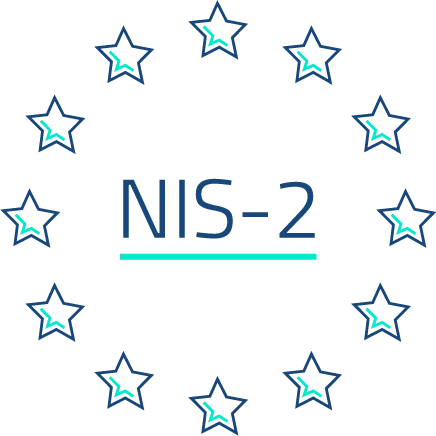BIC Process Design
Understand & Transform
Supercharge your business operations with the most intuitive AI-powered BPM software.
It seems that you come from a German speaking country. Here you can change the language
EnglishThe NIS 2 Directive (EU) brings major new obligations with fixed deadlines for thousands of companies – from strict ICT security requirements to comprehensive incident reporting. Find out which sectors are affected, what the NIS 2 Implementation Law includes, how NIS 2 compares to DORA and ISO 27001, and how smart tools combined with expert guidance can help your business achieve compliance with ease.

Table of Contents
Author
Martin Tanzer

Adopted on December 14, 2022, the NIS 2 Directive (EU 2022/2555) is a major update and expansion of the original 2016 NIS Directive. As a comprehensive EU cybersecurity regulation, it lays the foundation for protecting network systems across Europe.


The NIS 2 Directive came into force on January 16, 2023, with member states required to transpose it into national law by October 18, 2024. In Germany, this is planned through the ‘IT Sicherheitsgesetz 3.0’ (IT Security Act 3.0), while in Austria the legal framework will be established via the ‘Netz- und Informationssystemsicherheitsgesetz’ (Network and Information System Security Act).
However, 19 member states – including Germany and Austria – missed the deadline. On May 7, 2025, the European Commission issued a formal notice (“reasoned opinion”), giving them two more months to comply. If they fail to do so, the case will be referred to the Court of Justice of the European Union.
Compared to the first NIS Directive, NIS 2 not only introduces much stricter requirements but also significantly expands its scope. In Germany, eight sectors were previously defined as critical under the KRITIS regulation. With NIS 2, this number rises to 18.
Early estimates suggest that in Germany alone, around 30,000 private and public institutions (including government agencies) will be affected by the new regulation. In Austria, the figure is expected to be around 4,000.
In general, only companies that meet both criteria are classified as essential or important entities and are therefore subject to the requirements of NIS 2. These businesses are required to register and submit specific company details to their national authority within three months.
That said, there are exceptions: smaller companies may also fall under NIS 2 if they’re the sole provider of a critical service or if their activities are vital to public order, security, or health.

It’s not only the affected entities themselves that are required to implement a comprehensive cybersecurity framework. Each member state must also do so individually. As part of a national security strategy, the following must be defined:
In addition, dedicated emergency response teams must be set up to act as contact points and provide support in helping organizations detect risks, take preventive action, and respond appropriately to incidents. These emergency teams include both CSIRTs (Computer Security Incident Response Teams) and CERTs (Computer Emergency Response Teams).
Risk management can only succeed with leadership commitment, which NIS 2 frames as “governance.” Management is required to implement risk management processes and approve a clear risk treatment plan. The directive also highlights the importance of employee training to strengthen security awareness and foster a strong risk management culture.
To enforce this, national authorities are granted broad powers of oversight and enforcement, including audits, security checks, and the ability to impose fines.
When a significant security incident occurs, affected entities must report it to the relevant national authorities. A “significant” incident is one that causes major operational disruption or financial losses, or results in substantial (im)material damage to legal or natural persons.
The reporting process follows a tiered approach:
NIS 2 requires affected entities to conduct a “proportionate” risk analysis covering people, processes, technology, and the supply chain. The focus is on ensuring that the benefits outweigh the effort and on distinguishing what’s truly necessary from what isn’t. In addition to business continuity, safeguarding information to ensure its confidentiality, integrity, and availability is a central priority.
NIS 2 also emphasizes supply chain risks, aiming to prevent issues with service providers or contractors from disrupting the operations of critical entities. Managed ICT service providers are considered especially high-risk.
A key goal of NIS 2 is to enhance international cooperation via national CSIRTs/CERTs, ENISA, and Europol. Improved information flow between these organizations is intended to ensure a coordinated cross-border response and support the creation of a European vulnerability database for better collective preparedness.
NIS 2 and DORA are currently among the most talked-about regulations in Europe. At first, it’s not always easy to tell them apart, especially since they overlap in several areas. Their security objectives and measures, in particular, show many similarities. So where do NIS 2 and DORA actually differ?


Another term that frequently comes up in this context is ISO 27001, the internationally recognized standard for information security, cybersecurity, and data protection. Although ISO 27001 itself is not a mandatory regulation, it’s often mentioned alongside NIS 2 and DORA. This is because ISO 27001 certification gives organizations a strong foundation for meeting NIS 2 and DORA requirements much more efficiently.
Penalties under NIS 2 depend on the classification and annual turnover of the entity involved.
The fines are set as follows:
In addition, both the organization and its management or board members can be held personally liable if they cannot show that adequate risk and information security measures were in place. Importantly, lack of knowledge or information doesn’t exempt anyone from fines or other sanctions, including dismissal, and can’t be used to reduce penalties.


Companies that were already subject to NIS regulations or that even hold ISO 27001 certification now have a clear advantage. In fact, those with active ISO certification report that around 80% of their NIS 2 preparation is already complete. However, many organizations that have not previously fallen under the directive are now finding themselves in a situation where they must start from scratch. This means they first need to acquire the right tools, define appropriate cybersecurity measures, and gradually build ICT risk awareness across the organization, from leadership to all employees.

A study from late 2024 found that companies affected by NIS 2 spend up to 80% of their IT budgets on cybersecurity and compliance. Total costs range from €100,000 to €1 million, depending on the company size. In 95% of cases, organizations had to divert funds from other areas, including risk and crisis management, HR, or emergency reserves, to cover the increased compliance demands. The administrative and technical effort, particularly around documentation, is significant. Medium-sized companies, in particular, will have to find a way of meeting the required standards without overstretching their budgets.

Modern supply chains are dynamic and increasingly complex. Under NIS 2, companies must protect not just their own operations but also monitor emerging risks across the entire supply chain, including those coming from external providers. ISO 27001 provides a useful framework, but implementation is often time- and cost-intensive. Reliable risk assessment requires supplier cooperation, regular audits, and thorough documentation.

NIS2 clearly pushes toward standardized cybersecurity measures, but it leaves much of the implementation open to interpretation. As a result, affected entities are often left to figure out on their own how to translate the requirements into practice, which leads to varying approaches across industries and organizations as well as considerable uncertainty about what "good enough" really means and how to achieve full compliance.
Cybersecurity should be firmly integrated into both the strategic and operational processes of any organization. While for many companies this is already standard practice, the public administration sector faces far greater challenges. The large number of government agencies and processes makes it hard to maintain oversight, and important decisions are slowed down by layers of bureaucracy. On top of that, advisory bodies often pursue their own agendas, which can delay progress further.

With NIS 2, public administration is now coming particularly into focus. Being part of the highly critical sectors, authorities carry huge responsibility. They not only need to secure their own systems but also act as role models for other organizations. At the same time, they are often the first point of contact for citizens, meaning any disruption can have serious consequences for society as a whole. This makes it all the more important for public agencies to establish clear structures and foster a strong security culture that extends from leadership down to daily operations.

Determine whether your organization falls under NIS 2 based on its size, annual revenue, and industry. You need to check yourself as the authorities in your country won’t do this for you.

NIS 2 likely increases the requirements for your ICT management and related risk management areas. Identify gaps in your current setup and take action on network security, supply chain security, incident management, and more.

Put in place technical and organizational measures to ensure business continuity even in the event of a crisis. This includes creating emergency and system recovery plans, assigning risk management responsibilities within the organization, and defining the necessary budget.

Define concrete measures and processes aligned with NIS 2 requirements for ICT risk management. Examples include risk analysis, assessment, and treatment, incident management with clear escalation paths to the authorities, supply chain monitoring, and employee training.

To make NIS 2 compliance easier, specialized risk management software is available. Specialized risk management software can make compliance easier. First, define your requirements and compare available solutions. Test the chosen software in a pilot phase, then roll it out organization-wide if you see your needs are fully met.

Implement mechanisms to continuously review the effectiveness of your processes and controls. Conduct regular internal audits to ensure your company is sufficiently protected against cyberattacks and that reporting to authorities works properly in the event of an incident.
BIC GRC from GBTEC provides a comprehensive platform to help you implement NIS 2 with ease. Its integrated modules for risk management, information security, data protection, business continuity, internal controls, and audits enable you to protect your organization from all types of cyber threats while ensuring transparent, demonstrable, and complete compliance with every NIS 2 requirement:
The NIS 2 Directive marks a major step forward for cybersecurity in Europe. It expands the range of organizations affected and sets higher standards for information security, risk management, and incident reporting. Particularly noteworthy are the clear responsibilities for management and the substantial fines for non-compliance.
Organizations impacted by NIS 2 need to review the effectiveness of their current processes, identify gaps, and implement measures in ICT risk management, business continuity, supply chain oversight, and incident reporting. The challenge lies not only in the complexity of the directive but also in tight budgets and limited resources.
Those who act early, however, gain a significant security advantage and greater resilience in times of crisis. Frameworks like ISO 27001 and specialized software solutions such as BIC GRC from GBTEC can make implementation significantly easier.

GRC Solutions Architect
Martin Tanzer brings years of invaluable experience, having designed and implemented data protection management systems with a strong focus on real-world impact. As an IT and organizational coach, he also focused on providing data protection training to help users effectively work with these systems. For over a year, Martin has been driving innovation as a GRC Solutions Architect at GBTEC, where he shapes the development, customization, and enhancement of the BIC GRC standard solutions – creating robust, standard-compliant software that’s easy to use and can be rapidly deployed.